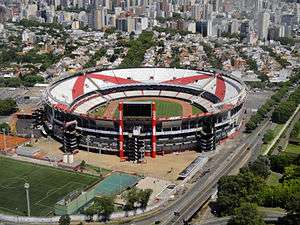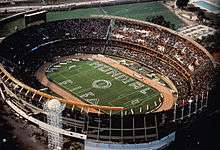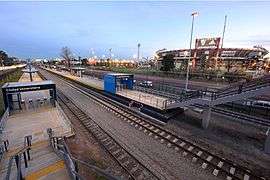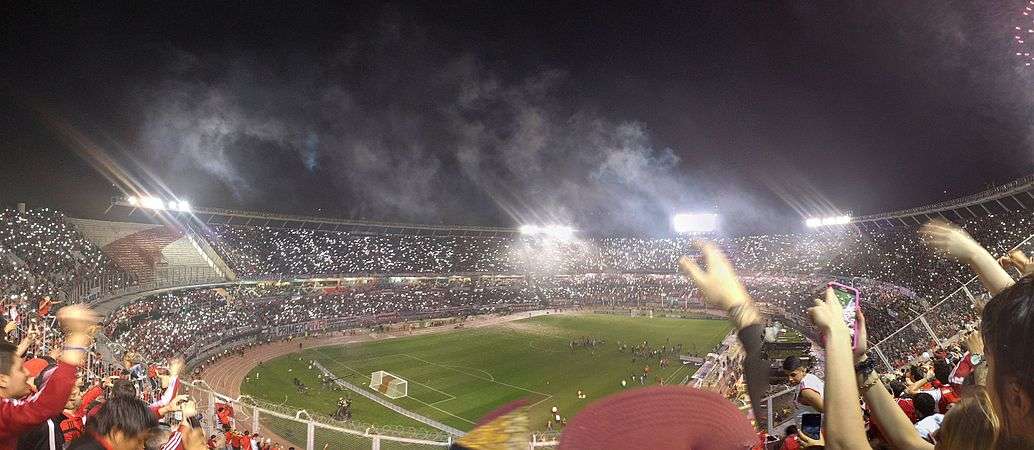Estadio Monumental Antonio Vespucio Liberti
|
El Monumental River Plate Stadium | |
 | |
| Full name | Estadio Antonio Vespucio Liberti |
|---|---|
| Former names | Estadio Monumental (1938–1986) |
| Location | Buenos Aires, Argentina |
| Owner | River Plate |
| Capacity | 70,127 |
| Record attendance | 100,000+ (River Plate vs Racing Club, 1975) |
| Field size | 105 x 68 m |
| Surface | Grass |
| Construction | |
| Built | 1936–1938 |
| Opened | 25 May 1938 |
| Renovated | 1978 |
| Architect |
José Aslan Héctor Ezcurra |
| Tenants | |
|
River Plate Argentina national football team Argentina national rugby union team | |
Estadio Antonio Vespucio Liberti (Spanish pronunciation: [esˈtaðjo monumenˈtal anˈtonjo βesˈpusjo liˈβeɾti]), also referred to as River Plate Stadium, Monumental de Núñez or simply El Monumental, is a stadium in the Belgrano district of Buenos Aires, Argentina (although popular belief wrongly states that the stadium is in the Núñez district), home of the football club River Plate.[1] It was opened on 25 May 1938 and named after former club president Antonio Vespucio Liberti. It is the largest stadium in Argentina with a capacity of 62,000 and is also home of the Argentina national football team. It was the main venue in the 1951 Pan American Games. It hosted the 1978 FIFA World Cup Final between Argentina and the Netherlands. Additionally, it hosted four finals of the Copa América, most recently in 2011.
History
The Club Atlético River Plate was founded in 1901 and by 1934, it had won two championships. At the time, the club was nicknamed "Los Millonarios" (The Millionaires in Spanish) because of the purchase of forward Carlos Peucelle for whom River had paid a huge amount of money. On October 31, 1934, River Plate purchased the land where the club was to build the new stadium in the neighborhood of Belgrano.[1]
El Monumental was built on land reclaimed from the marshy coast of Río de la Plata. On May 25, 1935, the cornerstone was laid on the Centennial (now Figueroa Alcorta) and Río de la Plata (Udaondo) Avenues. On December 1 of that year, the Steering Committee presented the approved project in detail to its members at an assembly. They obtained a loan of $2,500,000 from the government and on September 27, 1936, construction began under the direction of architects José Aslan and Héctor Ezcurra.
The initial cost of work reached the figure of $4,479,545.80, but was reduced to about 3 million dollars when the committee decided to halt the construction of the north end of the stadium due to a lack of adequate funds.[1]
The foundation of the stadium was to be six or eight feet deep. This required open pit excavation to ensure the stability of the ground, and pumping bilge water from the site. The construction of the three stands was completed in two years. There are 50 km of steps, with 26,000 square meters of reinforced concrete and almost 3,000 tons of steel.
The stadium was inaugurated on Wednesday 25 May, amidst a crowd of approximately 65,000 people. They witnessed the handing over of an Argentine flag, one from the club, paid for by a group of associates, and then sang the national anthem and the River Plate chant.
The next day, nearly 68,000 spectators were present. After various activities the evening ended with a match between River Plate and Uruguay team Peñarol, with a 3–1 victory for the home squad.
In the 2016-17 league season, River Plate drew an average home attendance of 37,000, the second-highest in the league.
Notable events
When the Monumental project was originally designed, it consisted of four double decker stands. As the bank loan was not enough to carry out the entire project, the stadium was left with a horseshoe shape. The horseshoe was partially enclosed in 1958, under the club presidency of Enrique Pardo. The new construction, the first tier Colonia stand, was financed by proceeds from the 10M pesos transfer of Omar Sivori to Juventus of Italy. With the new construction the stadium's capacity reached 90,000.
The stadium was remodelled and finally completed to meet the original project after Argentina was awarded the right to host the 1978 World Cup. River Plate was lent money by the Military Government in charge of the country at the time but they struggled to meet repayments due to the changes of currency, which had a detrimental effect on the team. Monumental was the headquarters for the 1978 World Cup. The venue was opened on June 1 for the match between West Germany and Poland. They hosted seven more games, including the final between Argentina and the Netherlands.
San Lorenzo earned the record for highest number of people attending a match for a visiting team in 1982. In their second division match against Tigre, San Lorenzo (which did not have a stadium at the time), brought more than 70,000 people to River's stadium. In 1975 when River played Racing for the title (after an 18 years drought) 100,000 were present. At the end of the 1986 and 1996 Copa Libertadores second-leg finals (both against América de Cali), more seats were added and approximately 86,000 spectators were in attendance. It is estimated that for the Argentina versus Uruguay 1987 Copa América semifinal more than 87,000 spectators attended. In 1993, in a qualification match for the 1994 FIFA World Cup, Argentina lost 5–0 to Colombia, its greatest ever defeat at home. Since then, however, Argentina has never lost a match in World Cup qualifying within this stadium until Ecuador won 2-0 on October 8, 2015.
The total length of the seating in the stands of the stadium is over 70 kilometers.
1978 FIFA World Cup

The stadium served as venue for the following matches during the World Cup:
| Date | R | G | Team 1 | Vs. | Team 2 |
|---|---|---|---|---|---|
| June 1 | 1 | 2 | 0–0 | ||
| June 2 | 1 | 1 | 2–1 | ||
| June 6 | 1 | 1 | 2–1 | ||
| June 10 | 1 | 1 | 1–0 | ||
| June 14 | 2 | A | 0–0 | ||
| June 18 | 2 | A | 1–0 | ||
| June 21 | 2 | A | 2–1 | ||
| June 24 | T | 2–1 | |||
| June 25 | F | 3–1 |
International Friendly Matches
| Date | Local | R | Visit |
|---|---|---|---|
| 14 May 1953 | 3–1 | ||
| 5 July 1953 | 1–0 | ||
| 24 June 1956 | 1–0 | ||
| 24 July 1960 | 2–0 | ||
| 18 November 1961 | 1–2 | ||
| 28 March 1962 | 1–0 | ||
| 1 December 1965 | 1–1 | ||
| 28 November 1976 | 0–0 | ||
| 25 April 1979 | 2–1 | ||
| 9 October 1980 | 2–0 | ||
| 12 October 1980 | 2–1 | ||
| 28 October 1981 | 1–2 | ||
| 11 November 1981 | 1–1 | ||
| 24 March 1982 | 1–1 | ||
| 14 April 1982 | 1–1 | ||
| 2 August 1984 | 0–0 | ||
| 9 May 1985 | 1–1 | ||
| 14 May 1985 | 2–0 | ||
| 20 June 1987 | 0–1 | ||
| 18 June 1992 | 2–0 | ||
| 27 December 1994 | 1–0 | ||
| 8 November 1995 | 0–1 | ||
| 25 May 1998 | 2–0 | ||
| 4 September 1999 | 2–0 | ||
| 24 May 2010 | 5–0 | ||
| 7 September 2010 | 4–1 | ||
| 20 June 2011 | 4–0 | ||
| 4 June 2014 | 3–0 |
Sporting events
The Monumental, aside from being River Plate's home ground, also accommodates the Argentine National Football Team in their home games for events such as the FIFA World Cup qualification.
The Monumental also hosted the closing ceremonies and the athletics events of the First Pan American Games in 1951.
The stadium host the first Super Special Stage of the 2007 Rally Argentina of WRC.
Rugby union matches featuring the Argentina national rugby union team, Los Pumas, also take place occasionally on this field, although the Pumas more frequently play at other stadiums.
Rugby Test Matches
Concerts
When an international performing artist or band visits Buenos Aires, the concerts are usually held in this stadium, as it is the biggest in the city and in all of Argentina.
The stadium played host to Amnesty International's final Human Rights Now! Benefit Concert on October 15, 1988. The show was headlined by Sting and Peter Gabriel and also featured Bruce Springsteen & The E Street Band, Tracy Chapman, Youssou N'Dour, León Gieco and Charly García.
David Bowie's Sound+Vision Tour was held in September 29, 1990. He sold more than 81,900 tickets from only one show.[2]
On October 5, 1990, Eric Clapton played a concert during his Journeyman World Tour in front of a sold out crowd of 70,000 people.[3]
Elton John performed at the stadium on November 21 & 22, 1992 during The One Tour. It was his first performance in Argentina.
Robbie Williams performed at the stadium on October 14 and 15 during his 2006 Close Encounters Tour
Guns N’ Roses first performed at the stadium with two concerts on December 5-6, 1992, as part of their Use Your Illusion Tour. Over half a year later on July 16–17, 1993, the band played two additional concerts as the final shows of the same tour, marking their last performances with most of their original lineup for over two decades. Twenty-three years later, the group reunited with classic members Slash and Duff McKagan, playing two shows on November 4-5, 2016, as part of the Not in This Lifetime... Tour.
In 1993, the American superstar Michael Jackson performed three sold-out concerts as part of his Dangerous World Tour at the stadium, on October 8, 10, and 12, for a total audience of 300,000 fans (100,000 people per show). The last concert was recorded for a documentary but it was later cancelled by Michael Jackson.
Paul McCartney played three concerts at the stadium in December 1993 during The New World Tour, for the first time in the country. Seventeen years later he returned to Argentina to play two concerts to a crowd of 82,000, as part of his Up and Coming Tour in November, 2010.
The Rolling Stones performed five sold out concerts at the stadium during the Voodoo Lounge Tour in 1995. The British band performed five times once again in 1998 for the Bridges to Babylon Tour, and two more times in 2006 during the A Bigger Bang tour. These last concerts were released as part of the four-disc concert DVD The Biggest Bang in 2007.
Seminal punk rock band The Ramones played their final South American show on March 16, 1996.
Backstreet Boys performed at the stadium on April 28, 2001 during Black & Blue Tour.
On October 6, 2001 Eric Clapton performed at the stadium during his Reptile World Tour, selling a total of 35,000 tickets.[4]
Aerosmith performed at the stadium in 2007 on Quilmes Rock show. The attendance was over 70,000 Spectators. The festival included the following bands Keane, Evanescence, Velvet Revolver, Bad Religion, The Psychedelic Furs.
The Police performed at Estadio Monumental on December 1 and 2, 2007 during their Reunion Tour. In 2008, the band released the live CD/DVD Certifiable that was recorded during this concerts.
Red Hot Chili Peppers played a concert at the stadium on October 16, 2002 during their By The Way Tour. Later they played another concert on September 18, 2011 during the I'm with You World Tour.
In 1998 Irish rock band U2 brought their PopMart Tour to South America and performed Mothers of the Disappeared with the Mothers of the Plaza de Mayo, the mothers of the children who had disappeared under the Argentinian and Chilean dictatorships, brought on stage. The band returned again for their Vertigo Tour in 2006 to film what would become U23D, the first live-action, 3D digital film.
Madonna performed two sold-out concerts in October 1993 during The Girlie Show[5] and another four in December 2008, during her Sticky & Sweet Tour; two of these concerts were filmed and later released on a CD/DVD titled Sticky & Sweet Tour. She holds the record for fastest sell-out of a concert at the stadium for her first show, with more than 263,000 tickets sold in three hours. She also performed at the stadium on December 13 and December 15, 2012 as part of The MDNA Tour.
In 2003, the international pop singer Shakira played a sold-out concert during her Tour of the Mongoose, being the first and only female Latin artist to sell out River Plate Stadium.
In May 15–16, 2007, High School Musical performed their hits from High School Musical The Tour, entitled High School Musical The Concert
In 2009 the British band Oasis presented one of the biggest concerts in their history. Noel Gallagher and the Argentine public shared an emotional moment, playing "Don't Look Back in Anger".
AC/DC performed three sold-out shows in December 2009, during their Black Ice World Tour. These shows were filmed and released on the DVD and Blu-ray Live at River Plate, was released in May 2011. In November 2012, they released a live album of the second of the three shows, which happened on the 4th of December.
Legendary New Jersey rockers Bon Jovi have played the stadium numerous times, most recently in 2010 as part of The Circle Tour.
The band Coldplay performed at the stadium on February 26, 2010 during Viva la Vida Tour.
In May 2011, the Teen Queen, Miley Cyrus brought her Gypsy Heart Tour which sold out in a week, filling the stadium with 65,000 people, becoming the third female artist to fill the stadium after Shakira and Madonna.
Roger Waters performed nine concerts at the stadium in March 2012, during which he and his band performed The Wall in its entirety on their 2010-2012 The Wall Live tour.[6]
Kiss played on September 3, 1994; March 14, 1997; April 10, 1999; April 5, 2009 and November 7, 2012. The 2009 concert was recorded and eventually released as a live six song DVD included on the Sonic Boom three disc package.[7]
Lady Gaga performed a sold-out show here for her tour The Born This Way Ball on November 16, 2012.
Iron Maiden performed at the venue on September 27, 2013 as part of the Maiden England World Tour. The legendary British metallers performed for over 60,000 people in a 145-minute show.[8]
Soda Stereo performed the final concert on September 20, 1997 during the farewell tour. This concert was recorded and released in two parts, El Último Concierto A and B and DVD. Later they performed a series of six sold-out historic concerts at the stadium in 2007 during the tour Me Verás Volver, holding the record of the South American and Spanish bands, with the most sold-out concerts at the same stadium. One of the concerts was recorded and became the CD/DVD Gira Me Verás Volver

Facilities

The stadium can house 74,624 people, after its renovation for the 1978 World Cup. The opening and final matches were both held in the Monumental, which had a capacity of 76,600 at the time because all of the popular stands were standing-only.

The stadium complex also has facilities for tennis, basketball, and other sports, as well as living quarters for young footballers, a theatre hall, a parking lot, museum etc. It can be accessed by several train and bus lines as it is located within walking distance from the Barrancas de Belgrano transportation hub. Contrary to most other stadiums in the Buenos Aires area, there is a sizable car park outside the stadium.
2014–2016 Renovation
In the recent years, with the new administration, the stadium has gone through an extensive renovation program that ranged from the people's logistic to the stadium's display.
- In November 2014, the stadium's display was removed and a new full-color led was installed, this one is 19,45m wide and 7,16m tall, tripling the size of the old one and making it the largest in a South American stadium.[9] On the same period a new Paddock Club and hospitality seatings were installed at field level.
- In August 2015, the Ciudad Universitaria station was opened on the Belgrano Norte Line in order to serve both the stadium and the University of Buenos Aires' Ciudad Universitaria campus located on the other side of the tracks. The stadium is linked to the station with a viaduct and the line connects the stadium to both central Buenos Aires through its Retiro terminal and also some of the city's northern outskirts.[10] There were extensive renovations in the bathrooms, and led screens were installed in boxes and stalls.
- In November 2015, the River Plate Museum was fully renewed: attractions were added and a River Plate store were built, where officially licensed products are sold.[11]
- In December 2015, a tempered glass envelope was installed over the outer lower rings of the stadium to create a better ambience to the spectators.
The renovation plan is still in progress as the club seeks funding for a large improvements plan which includes rising stadium capacity to 80.000 spectators.
See also
![]()
References
- 1 2 3 The Stadium Guide. "El Monumental". Archived from the original on 29 April 2012. Retrieved 11 May 2012.
- ↑ Kinder, Paul. "The Sound+Vision Tour". Archived from the original on 25 April 2012. Retrieved 11 May 2012.
- ↑ "Después de once años, Eric Clapton vuelve a Argentina – Suplemento Estilo – Diario Los Andes". Estilo (in Spanish). Los Andes. 6 October 2001. Archived from the original on 8 March 2016. Retrieved 27 February 2016.
- ↑ "Eric Clapton y su Visita al Argentina en 2001". Taringa! (in Spanish). Wiroos. Archived from the original on 4 March 2016. Retrieved 24 February 2016.
- ↑ "Madonna.com". madonna.com. Archived from the original on 2010-01-02.
- ↑ "Tour dates". rogerwaters.com. Archived from the original on 26 February 2012.
- ↑ List of Kiss concert tours
- ↑ "Iron Maiden reunió en River a dos generaciones de "metaleros"". lanacion.com.ar. Archived from the original on 2013-10-04.
- ↑ Plate, Club Atletico River. "River Plate inauguró la pantalla de LED más grande de Sudamérica". caRiverPlate.com.ar. Archived from the original on 2017-03-07. Retrieved 2016-12-20.
- ↑ "Inauguran hoy la estación de tren de Ciudad Universitaria" Archived 2015-08-30 at the Wayback Machine., Clarín, 29 Ago 2015
- ↑ Plate, Club Atletico River. "Se reinauguró el Museo River". caRiverPlate.com.ar. Archived from the original on 2016-07-02. Retrieved 2016-12-20.
External links
| Wikimedia Commons has media related to Estadio Monumental Antonio Vespucio Liberti. |
- Sitio Oficial del Club Atlético River Plate
- Stadium picture
- Club Atlético River Plate official history
- In depth history of 'El Monumental'
- History of the stadium 'El Monumental' (written by fans)
| Preceded by Estadio Nacional Santiago |
Copa América Final Venue 1946 |
Succeeded by Estadio George Capwell Guayaquil |
| Preceded by None |
Pan American Games Main Stadium 1951 |
Succeeded by Estadio Olímpico Universitario Mexico City |
| Preceded by Estadio Nacional Lima |
Copa América Final Venue 1959 |
Succeeded by Estadio Modelo Guayaquil |
| Preceded by Waldstadion Frankfurt |
FIFA World Cup Opening Venue 1978 |
Succeeded by Camp Nou Barcelona |
| Preceded by Olympiastadion Munich |
FIFA World Cup Final Venue 1978 |
Succeeded by Santiago Bernabéu Madrid |
| Preceded by two-legged final |
Copa América Final Venue 1987 |
Succeeded by Estádio do Maracanã Rio de Janeiro |
| Preceded by Estadio José Pachencho Romero Maracaibo |
Copa América Final Venue 2011 |
Succeeded by Estadio Nacional Julio Martínez Prádanos Santiago |
Coordinates: 34°32′43.15″S 58°26′59.05″W / 34.5453194°S 58.4497361°W
